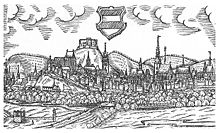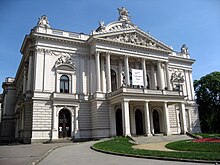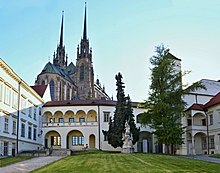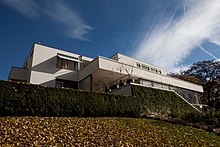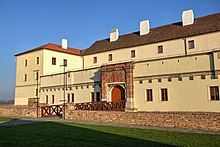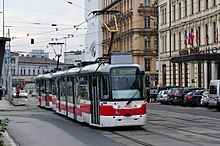Brno
| Brno | ||||
|---|---|---|---|---|
|
||||
| Basic data | ||||
| State : |
|
|||
| Historical part of the country : | Moravia | |||
| Region : | Jihomoravský kraj | |||
| District : | Brno-město | |||
| Area : | 23,020 ha | |||
| Geographic location : | 49 ° 12 ' N , 16 ° 36' E | |||
| Height: | 237 m nm | |||
| Residents : | 380,681 (Jan 1, 2019) | |||
| Postal code : | 602 00 | |||
| License plate : | B. | |||
| traffic | ||||
| Street: | Motorways D1 , D2 and D52 | |||
| Railway connection: |
Brno – Havlíčkův Brod , Brno – Břeclav , Brno – Přerov , Brno – Česká Třebová , Brno – Tišnov , Brno – Vlárský průsmyk |
|||
| Next international airport : | Brno-Turany Airport | |||
| structure | ||||
| Status: | Statutory city | |||
| Districts: | 29 | |||
| administration | ||||
| Lord Mayor : | Markéta Vaňková (ODS) (as of July 6, 2019) | |||
| Address: | Dominikánské nám. 1 601 67 Brno |
|||
| Municipality number: | 582786 | |||
| Website : | www.brno.cz | |||

Brno ( Czech Brno ), with about 380,000 inhabitants after Prague , the second largest city in the Czech Republic . The town, which has been the historical center of Moravia since the 17th century , is today the administrative seat of the South Moravian Region ( Jihomoravský kraj ). Brno has several universities, is an important research location and the seat of the Brno diocese of the Roman Catholic Church of the Czech Republic .
All organs of the highest Czech judiciary are located in Brno . These are the Constitutional Court of the Czech Republic ( Ústavní soud ), the Supreme Court ( Nejvyšší soud ), i.e. the highest instance of ordinary jurisdiction, the Supreme Administrative Court and the General Prosecutor's Office . The city is also the seat of the Czech ombudsman and the highest competition authority .
The city has an important position as a strong industrial, commercial, cultural and administrative center. In a spacious area, the Brno Exhibition Center in the Pisárky district, several important trade fairs for the Czech economy take place every year .
geography
location
Brno lies on the south-eastern edge of the Bohemian-Moravian Highlands . The river Svratka and the Svitava , which comes from the town of Svitavy and flows into the Svratka at the southern city limits, flow through the town . At the north-western city limits, the Svratka is dammed into an approximately 9.5 km long and at its widest point approximately 600 m wide reservoir Brněnská přehrada .
The urban area is at an altitude of 190 - 479 m above sea level. The highest point is the Kopeček mountain (479 m above sea level) on the western edge of the urban area.
climate
The annual average temperature is 9.4 ° C, the average annual precipitation around 505 mm. The average annual sunshine is 1771 hours and there are 150 days of precipitation annually.
| Brno | ||||||||||||||||||||||||||||||||||||||||||||||||
|---|---|---|---|---|---|---|---|---|---|---|---|---|---|---|---|---|---|---|---|---|---|---|---|---|---|---|---|---|---|---|---|---|---|---|---|---|---|---|---|---|---|---|---|---|---|---|---|---|
| Climate diagram | ||||||||||||||||||||||||||||||||||||||||||||||||
| ||||||||||||||||||||||||||||||||||||||||||||||||
|
Average monthly temperatures and rainfall for Brno
|
|||||||||||||||||||||||||||||||||||||||||||||||||||||||||||||||||||||||||||||||||||||||||||||||||||||||||||||||||||||||||||||||||||||||||||||||||||||||||||||||||||||
history
The prehistoric settlement Eburodunum mentioned in the work of Ptolemy was probably located in today's urban area .
Brno Castle was built between 1021 and 1034 and later gave its name to the adjacent settlement. The settlement of Brno was mentioned for the first time in 1091. The city was founded in 1243 by Wenceslaus I as a royal city (Bohemia) . The Špilberk fortress is mentioned for the first time in 1277 as a castle. From 1349 Brno was the seat of the Marquis of Moravia . In 1641 Brno replaced Olomouc as the capital of Moravia .
In the Thirty Years' War Brno was besieged unsuccessfully by the Swedish general Lennart Torstensson in 1643 and again between May 4 and August 23, 1645 . Brno replaced the destroyed Ölmütz as the capital of Moravia. About a hundred years later, on March 29, 1742, the First Silesian War brought Prussian troops to the city.
19th century
In 1805 the battle of Austerlitz between the Austrian and Russian armies on the one hand and the army of the French emperor Napoleon I on the other took place near the city . Napoleon Bonaparte visited Brno twice that year: from November 20, 1805 stayed until the night of November 29, after his victory he stayed again from December 7 to 12. In September 1809 he came back to the city, where his army had been waiting for him since July 13th. In the French park Lužánky ( German : Augarten ), newly founded by Emperor Joseph II from 1786–1787 , Napoleon's soldiers and the Brno dignitaries held a belated birthday party for the French guest (Napoleon had turned 40 on August 15, 1809). On Napoleon's orders, the Brno city fortifications lost their function as fortresses, but remained as structures.
On July 7, 1839, the railway connection to Vienna was opened, a section of the first long-distance railway in the Austrian Empire . Shortly after the establishment of the Ringstrasse as an example the now long since useless fortifications were demolished, instead of the "hills" was begun in 1860/61 after plans by Ludwig Förster also a ring road . Some of the green spaces remained, some of them were framed by representative buildings such as the main train station or today's Mahen-Theater (by Fellner and Helmer).
20th century
Around 1900, Brno had a predominantly German-speaking population (63%), while the suburbs outside the city center, which were not part of the Brno urban area until 1918, were predominantly Czech-speaking. Life in Brno was therefore bilingual and “Brno” can be understood as a mixture of the two languages.
After the First World War , almost 55,000 German-speaking citizens lived in Brno. These included predominantly the approximately 12,000 Jewish citizens living in the city, among them several well-known personalities who played a key role in the city's cultural life. In 1930 around 52,000 residents declared themselves German and 200,000 Czech, including Jewish residents of both nationalities.
After the establishment of the Protectorate of Bohemia and Moravia in March 1939 and the beginning of the Second World War , the systematic persecution of Jews began in Brno as well. By the end of the war, 9,064 Jewish townspeople were deported from Brno to various concentration and extermination camps ; only about 700 of them survived. Stumbling blocks and memorial stones in memory of the victims of National Socialism have been laid in Brno since 2010 .
During the German occupation, there was a German regional court in Brno from April 14, 1939, and from 1940 also a special court.
After the end of World War II , the German-speaking population was forced out of the city of Brno marketed unless they lived in mixed marriages. Their property was confiscated by the Beneš decree 108 , the property of the Protestant church was liquidated by the Beneš decree 131 and the Catholic city churches were expropriated . The Czech Republic made no compensation for the confiscated assets. In the Brno death march (beginning on May 31, 1945) around 27,000 mostly old and young citizens had to march to the Austrian border, 60 km away. According to the accounts of those involved, around 5,200 people were killed, "officially" documented 2,000 deaths. In 2015, the Brno city council regretted the eviction and invited representatives from associations of IDPs to a joint memorial .

During the period of Czechoslovak socialism , Brno maintained its position as one of the country's leading industrial cities. Prefabricated housing estates were built on the outskirts for the steadily growing population .
From 9 to 16 July 1973, the V. were in Brno International Fire Brigade Competitions of CTIF (short: Firemen Olympics) organized. The program included traditional international fire service competitions and, for the first time, international fire service sports competitions .
In 1993 an asteroid was named after Brno: (2889) Brno . In 1998 the first mosque in the Czech Republic (without a minaret and without a dome roof) was built in Brno .
Demographics
As of December 31, 2014, Brno had 377,440 inhabitants (official information from the Czech Statistical Office), making it the second largest city in the Czech Republic.
| year | Residents | Remarks |
|---|---|---|
| 1770 | 14,972 | with the suburbs |
| 1786 | 10,460 | excluding the suburbs, in 554 residential buildings, 2,606 Christian and 30 Jewish families |
| 1791 | 9,807 | excluding the suburbs, in 717 houses |
| 1804 | 17,043 | without the suburbs |
| 1835 | 35,948 | |
| 1852 | 49,000 | |
| 1857 | 58,809 | |
| 1869 | 73,771 | without the garrison (approx. 5,000 men), in 2,286 houses |
| 1900 | 109,346 | at the end of the year with the garrison (4,548 men), including 68,702 Germans and 38,365 Czechs |
| 1909 | 122,700 |
| year | 2000 | 2002 | 2004 | 2005 | 2006 | 2008 | 2014 |
|---|---|---|---|---|---|---|---|
| Residents | 381,862 | 370.505 | 367.729 | 366,757 | 366.680 | 370,592 | 377,440 |
language
In addition to the Czech Moravian form, the town language Hantec was used in Brno until the 20th century , a Czech dialect with a proportion of German loanwords. The Hantec seemed to be forgotten more and more by the turn of the millennium. Since then, the Hantec has again appeared more frequently in local culture and in everyday dealings.
Before the Second World War, German was the language of large parts of the upper middle class and also of many Jews in Brno. With the persecution of the Jews by the National Socialists and the flight and expulsion of the Germans after the Second World War, the German language has almost completely disappeared from the population.
Politics and administration

Brno is a statutory city . The urban area is identical to the Brno-City district . Brno is also the administrative center of the Jihomoravský kraj (South Moravian Region).
City structure
The city of Brno is divided into 29 urban districts, of which 58 districts belong:
- Bohunice ( Bohonitz )
- Bosonohy ( Parfoot )
- Bystrc ( Bisterz )
- Černovice ( Tschernowitz )
- Chrlice ( Chirlitz )
- Ivanovice ( Eiwanowitz )
- Jehnice ( Jechnitz )
- Brno-jih (Brno-South), consisting of Dolní Heršpice ( Unter Gerspitz ), Horní Heršpice ( Upper Gerspitz ), Přízřenice ( Priesenitz ), Komárov ( Kumrowitz ) and Trnitá (proportionally)
- Jundrov ( Jundorf ), consisting of Jundrov (partly) and Pisárky (partly; Schreibwald )
- Kníničky ( Klein Kinitz )
- Kohoutovice, consisting of Kohoutovice ( Kohoutowitz ), Pisárky (partly; Schreibwald ) and Jundrov (partly)
- Komín ( Komein )
- Královo Pole , consisting of Černá Pole (partially; Schwarzfeld ), Královo Pole ( Königsfeld ), Ponava and Sadová
- Líšeň ( delete )
- Maloměřice a Obřany, consisting of Maloměřice (proportionally; Malmeritz ) and Obřany ( Oberseß )
- Medlánky ( Medlan )
- Nový Lískovec ( New Leskau )
- Ořešín ( Orscheschin )
- Řečkovice a Mokrá Hora, consisting of Řečkovice ( Retschkowitz ) and Mokrá Hora ( Mokrahora )
- Brno-sever (Brno-North), consisting of Černá Pole (proportionally; Schwarzfeld ), Husovice ( Hussowitz ), Lesná, Soběšice ( Obeschitz ) and Zábrdovice (proportionally; Obrowitz )
- Slatina ( Latin )
- Starý Lískovec ( Old Leskau )
- Brno-střed (Brno-center), consisting of
- Brno-město ( Brno City ) with the old town,
- Pisárky (proportionately),
- Staré Brno ( Altbrünn ) west of the old town,
- Stránice,
- Štýřice,
- Veveří ( Eichhorn ),
- Trnitá (proportionally)
- Tuřany, consisting of Brněnské Ivanovice ( Nennowitz ), Dvorska ( Maxdorf ), Holásky ( Holasek ) and Tuřany ( Turas )
- Útěchov ( Autiechau , older also Dreihöfen )
- Vinohrady ( vineyards ), consisting of Židenice (partly; Schimitz ) and Maloměřice (partly; Malmeritz )
- Žabovřesky ( Sebrowitz )
- Žebětín ( Schebetein )
- Židenice, consisting of Zábrdovice ( Obrowitz ) and Židenice (partly; Schimitz )
mayor
The elected city council ( Zastupitelstvo města Brna ) has 55 members. They elect the city government ( rada ) and the mayor ( primátor ) from among their ranks .
- 1784–1804 Franz Rauscher
- 1804–1821 Johann Czikann
- 1828–1847 Johann Ritschel
- 1851–1855 Anton von Haberler
- 1855–1861 Rudolf von Ott
- 1861–1864 Christian d'Elvert
- 1864–1866 Alfred Skene
- 1866–1867 Karl Giskra
- 1868–1870 Rudolf von Ott
- 1870–1876 Christian d'Elvert
- 1876–1880 Karl van der Strass
- 1880–1894 Gustav Winterholler
- 1894–1916 August Wieser
- 1916–1918 Ferdinand Schnitzler
- 1918–1920 Petr Kerndlmayer
- 1920 Karel Vaněk
- 1920–1925 Bedřich Macků
- 1925–1935 Karel Tomeš
- 1935–1939 Rudolf Walk
- 1942–1945 Oskar Judex
- 1945-1946 Vladimír Matula
- 1946–1948 Josef Podsedník
- 1948–1949 Vladimír Matula
- 1949–1952 Bohumil Ubr
- 1952–1954 Vladimír Matula
- 1954–1963 Josef Kalášek
- 1963–1971 Oldřich Vaverka
- 1971–1976 Vladimír Štroner
- 1976–1980 František Chabičovský
- 1980–1983 Rudolf Suchánek
- 1983–1989 Alois Skoupý
- 1989–1990 Josef Pernica
- 1990 Jiří Trmač
- 1990 Pavel Podsedník
- 1990-1992 Václav Mencl
- 1992–1994 Jiří Horák
- 1994–1998 Dagmar Lastovecká
- 1998-2004 Petr Duchoň
- 2004-2006 Richard Svoboda
- 2006–2014 Roman Onderka
- 2014-2018 Petr Vokřál
- since 2018 Markéta Vaňková
Town twinning
Brno has twinned cities with the following cities:
|
In 1953, the city of Schwäbisch Gmünd sponsored all expelled Germans from the city of Brno.
religion
Culture and sights
The historic city center was declared an urban monument reserve in 1989 .
Theaters and museums
- Reduta theater
- National Theater Brno : the Mahen Theater (the former German theater), named after Jiří Mahen since 1965
- National Theater Brno: the Janáček Theater named after Leoš Janáček , opened in 1965
- Brno City Theater ( Městské divadlo Brno )
- Theater on Veveří Street (Eichhorn Street)
The second largest national museum, the Moravian State Museum , has existed in Brno since 1817. The second largest national library, the Moravian State Library , has existed since 1958.
The Museum of Roma Culture was opened in Brno in 1991 as the first of its kind in the world; the Technical Museum in the Královo Pole district reopened in 1997.
The Dům umění ( House of Art ) was built between 1908 and 1911 as the Emperor Franz Joseph's jubilee artist house.
music
The Brno Filharmonic Orchestra has its concert hall in Besední dům.
Buildings
Because of numerous buildings of Moravian functionalism , Bettina Hartz called Brno the "Tel Aviv of the North".
Sacred buildings
- Abbey of St. Thomas in Old Brno
- Petrov Hill with St. Peter and Paul Cathedral
- Bishop's court
- St. Thomas Church
- St. Jacob's Church with the ossuary
- Minorite Monastery and the Church of St. Johannen
- Red Church
- Convent of the Exaltation of the Cross and crypt of the Capuchin Order
- Synagogue of Agudas Achim
- Jewish Cemetery
Others
- Villa Tugendhat , UNESCO World Heritage
- Špilberk fortress
- Old Town Hall ( Stará radnice )
- Dietrichstein Palace, main building of the Moravian State Museum
- City Park Augarten (Lužánky) at the Ponávka located
- former Mercury fountain in the bishop's court
- Veveří Castle , on the north-western outskirts
- Brno dam
- Brno Exhibition Center
- Brno Zoo (inaugurated in 1953), on Mniší hora in the Bystrc district
- former Werkbund settlement in Žabovřesky
- Zderad column, Gothic column on Kröna-Str. ( Křenova ulice ) near the Svitava to commemorate the death of Zderad von Schwabenitz († 1091)
- Labyrinth under the herb market
- Brno clock on Freedom Square
- Villa Löw-Beer (an Art Nouveau villa)
Green spaces and recreation
- The Špilberk Park is located on the castle of the same name.
- The Denis´ Park (Park Denisovy Sady) is located under the Petersberg (Petrov).
- Botanical Garden of the Mendel University (Třída Generála Píky 584/1 Brno-Ponava)
Sports
Brno has, among other things, a cycling track on which the 1981 track cycling world championships were held. The lift opened in 1974, is open and has a 400 meter long concrete runway. The Brno Automotodrom is located on the western edge of the city . Brno is also traditionally home to major football and ice hockey clubs: at the moment it is the FC Zbrojovka Brno football club and the HC Kometa Brno ice hockey club .
Regular events
- Automotodrom Brno (formerly "Masaryk-Ring" ) - motorcycle world championship of the Czech Republic
- Ignis Brunensis - international competition of pyrotechnics and fire show
- Moravian Autumn ( Moravský podzim ), classical music festival
- international theater world festival ( Divadelní svět )
- Mezipatra, Queer Film Festival
Economy and Infrastructure
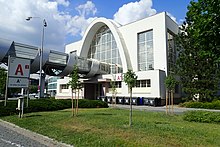
From the 19th century Brno developed into a strong industrial city. In the beginning, the textile industry was particularly important. The traditional companies include or belonged to the arms and mechanical engineering factory Československá zbrojovka as Brno (today: Zbrojovka Brno as), the tractor manufacturer Zetor and the mechanical engineering company Královopolská (founded in 1889 as Lederer-Porgess Königsfelder Maschinenfabrik ). Slévárna Heunisch Brno ( Heunisch-Guss ) was added in the summer of 2006 through the takeover of the Zetor foundry .
Today Brno is a trading center and an important trade fair city. Around 50 trade fairs are held annually. Numerous research institutions and universities make the city an important research center. The tallest skyscraper in the Czech Republic is in Brno, the AZ Tower , which was built in 2013 .
Unemployment was 3.8% in June 2019.
The Automotodrom Brno ( Masaryk Ring ), a motor racing circuit, is located near the city .
education
Brno is one of the most important Czech university cities, there are six university institutions here. The largest is the Masaryk University (founded in 1919) with around 32,000 students, followed by the Technical University of Brno (founded in 1899) with over 18,000 students, then the Mendel University in Brno , the University of Veterinary Medicine and Pharmacy in Brno , the Janáček University Academy of Music and Performing Arts Brno (JAMU) and the Military University of Defense .
traffic
Transportation
The city's modern, area-wide public transport system consists of 11 tram lines , 13 trolleybus lines , 35 bus lines , 11 night bus lines and a ship line on the reservoir. The suburban is Transport Association Integrovany dopravni system Jihomoravského kraje together (IDS). A special feature of Brno is the city-specific colloquial term Šalina (pronounced Schallina ) for tram.
railroad
Brno is an important railway junction. In 1839 the city was connected to the Austrian Northern Railway . Today the city is located on a European railroad . There are direct Eurocity trains Budapest / Vienna - Prague - Berlin - Hamburg . On the Prague - Brno route, the maximum speed limit for trains is 160 km / h, but this can only be reached by Eurocity trains. The line is part of the so-called "First Railway Corridor", a modernization program planned since the mid-1990s.
For some time now, the construction of a new train station has been planned instead of the old train station , which is outdated in terms of traffic technology . Its building, as well as the neighboring post office, are listed. The new building is planned around 800 meters south of the previous station. There is lively resistance to this urgent project (from the point of view of the city representatives). Financing has not been clarified either.
Trunk roads
The D1 motorway leads from Prague via Brno towards Ostrava . The D2 motorway connects the city with the Slovakian border and continues to Bratislava . A trunk road connection from Brno to Vienna exists, on the Austrian side in the form of the A5 motorway , but needs improvement on the Czech side.
A system of inner-city motorways, the so-called Great City Ring ( Velký městský okruh ), has been built in Brno for several years . This includes four already passable tunnels. The most elaborate tunnel with a length of 831 m was built under the Královo Pole district ( Královopolský tunel ). The noise protection of the Königsfeld tunnel was improved again after citizen protests and court judgments. The delays in the construction of the tunnel of at least three months have led to considerable increases in costs. The total cost of the tunnel has been provisionally estimated at around seven billion crowns (around € 280 million), but has not yet been officially confirmed. The Königsfeld tunnel was presented to the public on June 2, 2012 as part of an “open day” and opened to traffic on August 31, 2012.
Air traffic
Brno International Airport ( IATA airport code BRQ, ICAO code LKTB) is located in the Tuřany district about ten kilometers east of the city center. There are regular flights to the cities of London, Milan and Berlin from here. In 2018, 500,000 passengers were carried.
Personalities
Others
In the 1950s and 1960s the Viennese emcee Heinz Conrads liked to sing the song How Bohemia was still with Austria, / fifty years ago, fifty years ago / my father got himself from Brno / a real Viennese. The singer Peter Alexander , who is known throughout the German-speaking region , also had this song in his repertoire.
Brünner Straße exists in the north of Vienna .
literature
Sorted by publication
- Christian d'Elvert : An attempt at a history of Brno . Traßler, Brno 1828 ( e-copy ).
- Gregor Wolny : The royal capital Brno and the rule Eisgrub, together with the surroundings of the latter, described topographically, statistically and historically. Brno 1836 ( e-copy. )
- Christian d'Elvert : Contributions to the history of the royal cities of Moravia, especially the k. State capital Brno . Volume 1, Brno 1860 ( e-copy ).
- Dora Müller: Brno hub. German and Austrian emigrants 1933–1939 / Přestupní stanice Brno. Němečtí a rakouští emigranti. German and Czech, book accompanying an exhibition of the same name. Deutscher Kulturverband Region Brünn, Brno 1997 (Brno as a refuge for German and Austrian exiles after the National Socialist seizure of power)
- Leopold Masur: Legends from Brno. Vitalis, Mitterfels 2008, ISBN 978-3-89919-121-9 .
- Irene Hanappi: Brno. 5 routes through the capital of Moravia. History, culture, sightseeing, food and drink. Falter 2007, ISBN 978-3-85439-396-2 .
Web links
- Website of the city of Brno
- German Cultural Association Brno Region Meeting Center Brno
- German Language and Culture Association Brno
Individual evidence
- ↑ Český statistický úřad - The population of the Czech municipalities as of January 1, 2019 (PDF; 7.4 MiB)
- ^ Heinrich Gottfried Philipp Gengler: Regesta and documents on the constitutional and legal history of German cities in the Middle Ages , Erlangen 1863, pp. 415–424 .
- ^ Lužánky (Augarten), Lidická 50 Encyclopedie Brna
- ↑ "Germans and Czechs" on bruenn.eu
- ^ Eva Hahn , Hans Henning Hahn : The expulsion in German memory. Legends, myths, history. Schöningh, Paderborn 2010, ISBN 978-3-506-77044-8 , p. 370.
- ^ Website of the Brno Jewish Community. History ( Memento from July 14, 2003 in the Internet Archive )
- ↑ Maximilian Becker, "Mitstreiter im Volkstumskampf: German Justice in the Integrated Eastern Regions 1939-1945", Walter de Gruyter, 2014, 351 pages, p. 46/47, https://books.google.de/books?id=vqvoBQAAQBAJ&pg = PA46 & lpg = PA46
- ↑ https://www.radio.cz/de/rubrik/geschichte/das-blutige-ende-des-zweiten-weltkriegs-im-protektorat Radio Prague, 10 min., Down. March 1, 2020
- ↑ "Office" is called Theodor Oberländer here . See Federal Ministry for Expellees, Refugees and War Victims , Theodor Schieder Hrsg .: The Expulsion of Germans from East Central Europe. Preparatory work by Fritz Valjavec . Part 4: The expulsion of the German population from Czechoslovakia. Bonn 1957, 2 volumes. For the nature of the publication, the editors and online access, see the Ministry's article
- ↑ Data of the asteroid (2889) Brno
- ↑ Population figures in the Czech Republic - Czech Statistical Office ( Memento from May 22, 2015 in the Internet Archive )
- ^ Christian d'Elvert : Contributions to the history of the royal cities of Moravia, especially the k. State capital Brno . Volume 1, Brno 1860, p. 15.
- ^ A b c Johann Max von Liechtenstein: Handbook of the newest geography of the Austrian imperial state . Volume 2, Vienna 1817, p. 972
- ↑ a b Tourist guide through Brno and its surroundings . Thuma, Brno 1874, p. 4.
- ^ Pierer's Universal Lexicon . Volume 3, Altenburg 1857. p. 372.
- ^ Carl Kořistka : The Margraviate of Moravia and the Duchy of Silesia in their geographical relationships . Vienna and Olmüz 1861, pp. 268–269 .
- ^ Meyer's Large Conversational Lexicon . 6th edition, Volume 3, Leipzig and Vienna 1905, pp. 499-501.
- ^ Municipal administration and municipal statistics of the regional capital Brno: Report of the mayor for the year 1909 . Brno 1913.
- ↑ Český statistický úřad ( Memento from April 2, 2015 in the Internet Archive )
- ↑ Population of Brno - Czech Statistical Office ( Memento from May 22, 2015 in the Internet Archive )
- ↑ Language: With the "vague" over "bergl" into "štatl" to "hokna" (para. 3)
- ↑ Moravská zemská knihovna v Brně: Map collection Moll
- ^ Website of the statutory city of Brno: Partnerships
- ^ Brno Architecture Manual
- ↑ Spectacularly brash . Where is the so-called "Tel Aviv of the North"? A stroll through the Czech Brno with its unique, floating architecture. In: Frankfurt Sunday newspaper . October 20, 2019, p. 52 : “Even on the square in front of the train station in Brno you are amazed if you haven't really arrived yet. The grace of Moravian functionalism ... "
- ↑ bikecult.com Bike Cult - Bicycle Tracks & Velodromes
- ↑ Moravský podzim site
- ↑ See the official website of the Europoint Brno project, published by the Brno City Administration, last updated on January 2, 2012. http://www.europointbrno.cz/index.php?nav01=6299
- ↑ a b http://brno.idnes.cz/tunely-uz-se-jezdi-auta-kolik-staly-silnicari-reknou-az-v-roce-2014-pxz-/brno-zpravy.aspx?c= A120831_1823232_brno-zpravy_bor /
- ↑ Česká televize: Na prohlídku do nových tunelů Dobrovského zavítaly tisíce lidí. Retrieved May 1, 2020 (Czech).
- ↑ More and more passengers at Brno IDnes Airport July 11, 2019
- ↑ https://www.youtube.com/watch?v=TmIGTjym91E
- ^ Sales by Theodor Kramer Society
- ^ Vanishing point Brno & The Sudetenland in the 1990s - two exhibitions in the Czech Center in Berlin Berliner Zeitung , September 11, 2000



